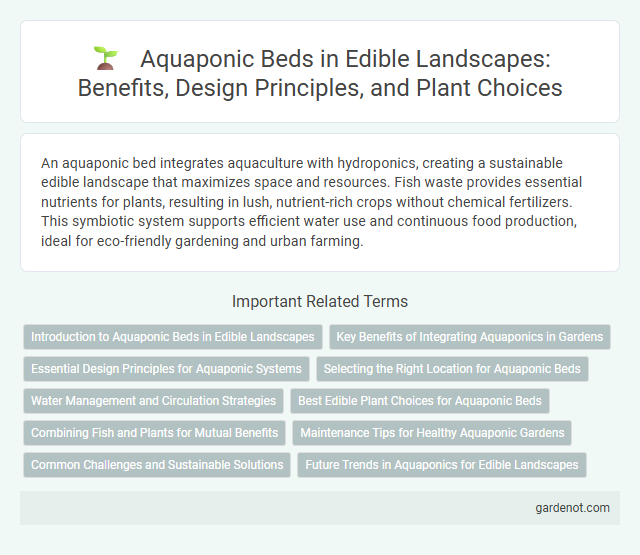An aquaponic bed integrates aquaculture with hydroponics, creating a sustainable edible landscape that maximizes space and resources. Fish waste provides essential nutrients for plants, resulting in lush, nutrient-rich crops without chemical fertilizers. This symbiotic system supports efficient water use and continuous food production, ideal for eco-friendly gardening and urban farming.
Introduction to Aquaponic Beds in Edible Landscapes
Aquaponic beds integrate aquaculture and hydroponics, creating a sustainable ecosystem where fish waste provides natural nutrients for plants, enhancing soil fertility in edible landscapes. This system conserves water by recycling nutrient-rich water between the fish tanks and plant beds, supporting efficient growth of vegetables and herbs. Aquaponic beds offer a productive method to maximize space and yield, promoting organic food production within urban and small-scale edible landscapes.
Key Benefits of Integrating Aquaponics in Gardens
Aquaponic beds combine fish farming and hydroponic plant cultivation, creating a sustainable, symbiotic environment that maximizes resource efficiency. Integrating aquaponics in gardens enhances water conservation by recycling nutrient-rich water, reduces the need for chemical fertilizers, and promotes faster plant growth with higher yields. This system supports organic produce production while minimizing environmental impact and encouraging biodiversity in edible landscapes.
Essential Design Principles for Aquaponic Systems
Aquaponic beds require balanced water flow rates between 1-2 liters per minute per square meter to optimize nutrient delivery and oxygenation for plant roots. Maintaining a pH range of 6.8 to 7.2 ensures nutrient availability and fish health, crucial for the symbiotic system. Proper media selection, such as expanded clay pellets or gravel, supports effective biofiltration and root anchorage, enhancing overall system stability and productivity.
Selecting the Right Location for Aquaponic Beds
Selecting the right location for aquaponic beds is essential to maximize sunlight exposure and maintain optimal temperature for fish and plant growth. Proximity to a water source and accessibility for maintenance ensure efficient system management and reduce resource waste. Proper site selection enhances nutrient cycling and supports a sustainable edible landscape.
Water Management and Circulation Strategies
Aquaponic beds utilize a closed-loop water management system that recirculates nutrient-rich water from fish tanks to grow edible plants, optimizing both water use and nutrient delivery. Advanced circulation strategies include the use of pumps and gravity-fed channels to maintain oxygenation and prevent water stagnation, ensuring healthy root systems and fish habitats. This integrated approach significantly reduces water consumption compared to traditional agriculture while promoting sustainable nutrient cycling.
Best Edible Plant Choices for Aquaponic Beds
Lettuce, spinach, and kale thrive in aquaponic beds due to their fast growth and nutrient absorption, making them ideal edible plant choices. Herbs like basil, mint, and cilantro also perform well, benefiting from the constant water circulation and nutrient-rich environment. Root vegetables such as radishes and beets can be successful with proper bed depth and oxygenation, enhancing the diversity of an edible aquaponic landscape.
Combining Fish and Plants for Mutual Benefits
Aquaponic beds integrate fish farming and hydroponic plant cultivation in a closed-loop system that maximizes resource efficiency and sustainability. Fish waste provides essential nutrients to plants, while the plants filter and purify the water, creating a balanced ecosystem that supports healthy growth for both organisms. This method enhances food production by producing protein-rich fish alongside nutrient-dense vegetables using minimal water and space.
Maintenance Tips for Healthy Aquaponic Gardens
Regularly monitor water quality by testing pH, ammonia, nitrite, and nitrate levels to maintain a balanced environment essential for plant and fish health in aquaponic beds. Remove plant debris and clean filters weekly to prevent blockages and ensure efficient nutrient circulation. Inspect fish behavior daily and adjust feeding routines to avoid overfeeding, which can lead to water contamination and harm the aquaponic ecosystem.
Common Challenges and Sustainable Solutions
Aquaponic beds often face challenges such as nutrient imbalance, water quality management, and pest control, which can impede plant growth and fish health. Implementing biofiltration systems, maintaining optimal pH and temperature levels, and integrating natural pest predators provide sustainable solutions to enhance system stability. Utilizing renewable energy sources and recirculating water minimizes environmental impact while promoting long-term productivity in edible landscape aquaponics.
Future Trends in Aquaponics for Edible Landscapes
Future trends in aquaponics for edible landscapes emphasize sustainable integration of fish and plant production to maximize space efficiency and resource use. Innovations include automated nutrient monitoring systems and renewable energy-powered operations to reduce environmental impact. Advances in crop and fish species diversification enhance resilience and year-round food production within urban and residential settings.
Aquaponic bed Infographic

 gardenot.com
gardenot.com